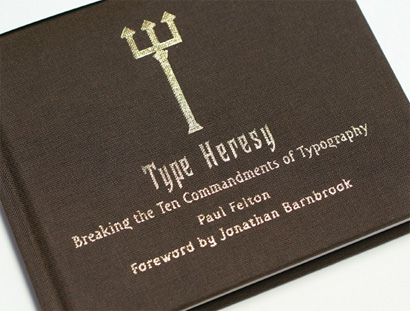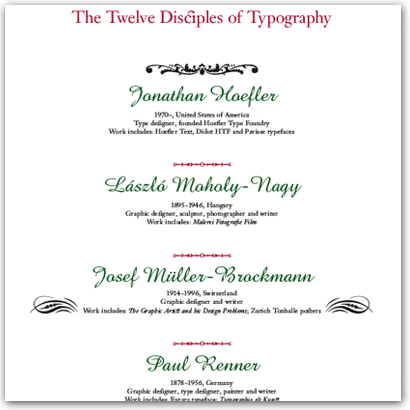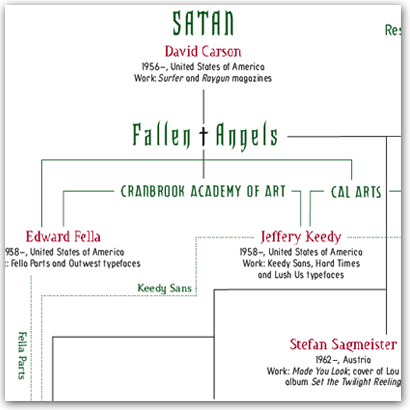I am a sucker for stories of courage and determination in the face of adversity, like that favorite man-tearjerker, Rudy, where the improbable becomes reality in a properly soundtracked climax. This emotional sappiness translates quite effectively when a design student’s thesis or senior project is so good that it gets published and sold on Amazon and other fine establishments. What can I say? It makes me happy.
Last year, Cristina Paoli’s Mexican Blackletter — her final project at LCC in London to receive an MA in Typo/Graphic Studies — was published by Mark Batty almost a year after she excitedly introduced her project on Typophile. And Paul Felton, a graduate of Staffordshire University, also stroke publishing gold with UK-based Merrell for his polarizing typography ditty The Ten Commandments of Typography/Type Heresy: Breaking the Ten Commandments of Typography, which also earned him a 2005 D&AD New Blood prize. A few weeks ago, strolling through the Cooper-Hewitt shop I was immediately attracted to its gold-foiled, cloth-bound hardcover, where I was then pulled in by the fight of Good Vs. Evil found within its off-white, thick, rich, uncoated pages.

Image pilfered from Segura Inc. (its founder, Carlos Segura, is part of the evilness).
The book is divided in two parts: The Ten Commandments of Typography on one side and vertical orientation and Type Heresy: Breaking the Ten Commandments of Typography on the other. Being the good boy that I am, I started with Commandments, where the author starts with a preface and introduction rendered in mock Bible speak about typography, “In the beginning God created type. And the world was without form, and void, and darkness was upon the face of legibility.” And so forth. Cute, but not quite convincing nor overly funny. The book starts to get interesting when Felton chooses the “Twelve Disciples of Typography” as the evangelists of that which is good and acceptable typography. “From his race of men He chose twelve of the worthy to be His type disciples and to spread the laws of typography to others.”

The Twelve Disciples of Typography. See full list as PDF, courtesy of Merrell Publishers.
“The Lord then spoke to His disciples,” continueth Felton, “and gave them the ten rules by which every typographer must abide, to gain passage to type Heaven.” I was very curious to read these ten commandments, since defining what good typography constitutes is a never-ending battle prone to end in “good typography is subjective”. Here then is what God intended:
1. Thou shalt not apply more than three typefaces in a document.
2. Thou shalt lay headlines large and at the top of the page.
3. Thou shalt employ no other type size than 8pt to 10pt for body copy.
4. Remember that a typeface that is not legible is not truly a typeface.
5. Honour thy kerning, so that white space becomes visually equalized between characters.
6. Thou shalt lay stress discreetly upon elements within text.
7. Thou shalt not use only capitals when setting vast body copy.
8. Thou shalt always align letters and words on a baseline.
9. Thou shalt use flush-left, ragged-right type alignment.
10. Thou shalt not make lines too short or too long.
Blocks of copy that act what they preach delicately illustrate each commandment, using, repeatedly, In the beginning God created type… as body copy. Whether it was decidedly intentional or not, this half of the book is rather boring, and the commandments do not feel too authoritative nor hard to follow. Very nicely typeset, though. Eager, I turned the book around to see some Evil typographically incarnate. Right from the start, Type Heresy is more interesting when Felton lists the 24 fonts he is going to use (as opposed to only unlucky 13 in Commandments). This second half feels a lot like 1995. And I’m liking it. It only gets better when the villain is presented, “Satan is the adversary of God. […] Followers of the Ten Commandments consider Satan to be a real being, created by God.” Many other evil traits are cast upon Satan, including its propensity to “bestow design accolades and awards upon one for a limited time.” The punchline, and a funny one, is, of course, David Carson and his Fallen Angels, a motley crew of anarchic designers and typographers.

Satan and his Fallen Angels — a global, interconnected, evil enclave! See full chart as PDF, courtesy of Merrell Publishers.
Type Heresy then goes on to debunk each commandment with illustrated typography and it does so quite efficiently. Helped in large part by supporting body copy that aids the visual stylings. When pissing on Commandment 7 (Thou shalt not use only capitals when setting vast body copy), the copy snarkily reads: “THE TEXT MAY MAKE MORE OF A DEMAND ON THE READER BUT WHAT THE HELL IS WRONG WITH THAT?” There is more passion, focus and determination in Type Heresy than there is in Commandments. Perhaps this shows Felton’s preference, a Fallen Angel himself. But more interestingly, it speaks of a broad style divide in graphic design. The Good Vs. Evil. And we all know which one is which.
As a simplistic conclusion, Felton’s book, Commandments and protagonists are a more or less a representation of the graphic design manifestations of Modernism and Postmodernism. The Clean Vs. The Layered. The Ordered Vs. The Chaotic. The Rigid Vs. The Loose. The Accepted Vs. The Heretic. During the late 80s and early 90s this division was clear and heartily debated and the Fallen Angels in Felton’s book are (mostly) clearly of this era. (A bygone one at that, though). And other than Massimo Vignelli (very oddly missing from the Disciples… unless he… is… God?!) and Steven Heller there were not many vocal heroes in the battle for typographic properness. So how do you choose the Disciples? Yes, Matthew Carter and Jonathan Hoefler make pretty typefaces and are, in real life, real nice people, but they are not necessarily involved in typesetting, Erik Spiekermann is not necessarily a rule follower, and Eric Gill is not necessarily heavenly.
What I find clear in Felton’s engaging, publish-worthy and beautifully produced book is that it’s the villains, evil-doers and against-the-current swimmers that stand out, are more memorable and are easier to band together. I should know, since I originally intended to follow in the steps of Satan as a young designer and emulated his and the Fallen Angel’s every torn typographic statement. Maybe I wasn’t evil enough and I eventually learned all the Commandments by following the design of Cahan & Associates, VSA Partners, Pentagram, Risgby Design, Liska, SamataMason and other adherents to straightness and cleanliness. Today, as a Disciple I long for some Fallen Angels or villains that we can contrast with, but it seems that being typographically on the fringe is not as easy as it used to be, with more and more artists and non-designers being able to manipulate design in unexpected ways and receiving the necessary attention. I’m cheering for the improbable these days. I want to see a Good Vs. Evil debate in graphic design. Where are the Fallen Angels?






Every new change in graphics has coincided with things going on with culture. But one of the most important paradigm shifts for designers these days (and one of the reasons post-modernism came into fruition) is because of a change in technology. Designing layouts (which was once more of a group effort) switched to a designing on the computer (which can sometimes be a one-person activity from start to finish). This more personal activity, mixed with the academic theory (semiotics, deconstructionism, etc) helped to set off the post-modernist era.
But since the mid eighties, there has really not been any real paradigm shift in technology, and much visual activity in the past few years has been spent trying to refine visuals that are a mix between computer and analog. Designers haven't really been taken out of their comfort zone, and so they keep the same process.
Armin, you asked where these fallen angels are. I think (coming from a person who has recently completed an education in graphic design) along with the industry, we need to start giving students an education in post-modernism rather than having them learn it themselves. I know a lot of people who don't even know this website, or even the existence of this discussion even exists.
Perhaps then we will start to see more new, rebellious, and sinful designers.
On Jun.02.2007 at 12:22 AM